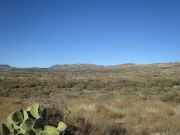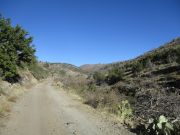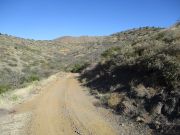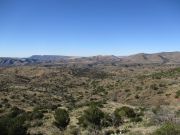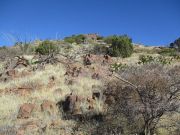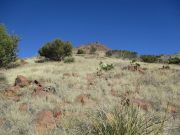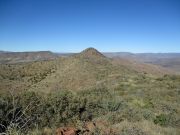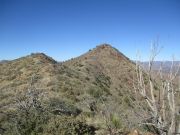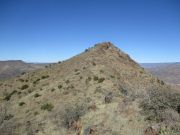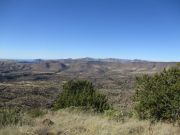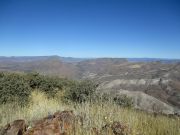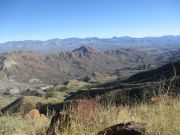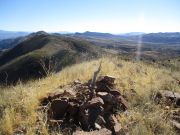
The Mountains of Arizona
• www.surgent.net
|
| Rover Peak |
• Verde River Valley • Tonto National Forest • Yavapai County |
|
Date: December 21, 2020
• Elevation: 5,279 feet
• Prominence: 919 feet
• Distance: 8.2 miles
• Time: 5 hours
• Gain: 2,080 feet (gross)
• Conditions: Warm and lovely
Arizona
•
Main
•
PB
•
LoJ
Rover Peak is a summit along a spine of mountains that overlook the Verde River to the east, and the New River Mountains to the west. Tonto National Forest Road 24 is the main access into the area. Other nearby mountains are Kentuck Mountain, Willow Spring Mountain and Humboldt Mountain with the FAA radome atop it. The summit of Rover Mountain lies inside Yavapai County, but most of my ascent from the south would be in Maricopa County.
This is one of my favorite parts of the state. Despite being on forest land, it is not a forest of trees, but mainly high desert hills and peaks, and very few people despite being close to Phoenix. A year ago, I was up here about twice a month hiking peaks, but since I moved to Payson in March 2020, this would be my first time back to the area. I had "saved" Rover Peak for a couple reasons: it would be a longer hike than the others, and it was one of the bigger summits, something to keep me motivated for a later visit.
I left Payson a little after 7 a.m., drove down to the Phoenix metro area, followed Shea Bulevard to the Loop-101, then onto northbound Scottsdale Road to Cave Creek Road and northeast into the hills, leaving Scottsdale behind and now on Forest land. The day was cool at first but warming, with blue skies and no clouds. From FR-24, I got onto FR-254, which is a little less than a mile past the turn-off to the Humboldt Mountain. According to the maps, FR-254 leads toward the Red Rover Mine, southeast of the peak.
I had studied the topographic maps and the satellite images showing the roads, because the maps are not accurate. Apparently, FR-254 does not go as far as the map says. A parallel road, FR-1094, does go all the way to the mine site, but for some reason, this road is not shown on the maps, even the recent Forest Service maps from 2016. (Older maps from the 1940s, and some newer maps such as OpenTopo, show this road. Why the new Forest Service maps erase it is beyond me. It's safe to assume this road has been there for a hundred years.) Once on FR-254, there is a Y-junction about a half-mile in, with FR-1094 going right. I followed FR-1094 for another "most" of a mile, past some power lines, going until I felt it unwise to proceed farther in my Subaru Forester. I parked in a rough clearing where FR-3196 junctions with FR-1094. It was 9:40 a.m. when I killed the engine, the temperature about 65 degrees. It was a stunning day, a little warmer than I would have expected for the Winter Solstice. I had driven 105 miles from home to here.
I got suited up and started walking at 9:50 a.m., following FR-1094 northbound into Walnut Spring Canyon. The road is wide and mostly in good shape. For a couple miles, the road stays within the canyon, criss-crossing the drainage many times. There were mature shade trees in spots, and plenty of ad-hoc camping spaces. The road then gains steeply to top out on a small saddle, then drops into the east fork of Juan's Canyon, which is parallel to Walnut Springs Canyon. The road runs up this canyon then gains again, coming to a locked gate at the Red Rover Mine site. To here, I had hiked about 3 miles, making good time.
The road to the gate looks to be maintained. Just a couple spots were rutted with erosion channels. Past the gate, the road leads to the Red Rover Mine site. This mine was active going back to the late 1800s and produced gold, silver and copper, and a small town sprung up. Information can be found at the Arizona Ghost Towns site and the Red Rover Mine site, which is pretty basic. The most active period was the mid-20th Century. Satellite images show a number of buildings still there, and there may be some small-scale mining going on today. I even found a home for sale here, on the realtor sites.
I was east of the town site and there was no need for me to poke around it. The gate had all sorts of signs warning about no trespassing, getting shot if you do, and other nonsensical signs that carry no legal weight but make the people posting them feel manly. Instead, I found a footpath to the right of the gate, and followed it up a few yards to catch an ATV track trending northwest. As I gained elevation, I could see the Red Rover townsite and buildings better, but saw no hint of people moving about. This ATV track heads to some old prospect sites, but the track lost distinction and disappeared. I continued straight uphill, aiming for a rock outcrop a couple hundred feet higher.
The going was steep but easy. There was abundant grass, cactus and spotty pinon, but always lanes to follow. The underlying rocks were apt to roll, and they did often. This would slow me down a lot. As I neared the rock outcrop, I angled slightly to my right (south) and weaved through the lower rocks and up to the ridge above it, then up an easy grade to the main ridge near Hill 5207. Once on top this ridge highpoint, I could see Rover Peak's summit again, a half mile to the north.
Here, the brush became more dense, and I angled downhill to a fenceline that runs along this portion of the ridge all the way to near the summit. I found a few lanes through the brush, but at times had to barge through it directly. I dropped about 140 feet to a saddle, then up about 50 feet to another bump, then down that, now below Rover Peak itself. I crossed this fence a couple times when it seemed smart to do so, generally trying to keep to less-brushy areas. The brush was bothersome but not terrible. However, the rocks rolled from under me every third step, it seemed, and it was tiring.
I hiked uphill to the top, about a 220-foot gain. Along the way, I came upon a low stone wall that ran about 20 feet, possibly put in by ancient Indians. Toward the top, the brush closed in, but I was able to get to the top without too many scratches and snags. The top is a small grassy hump with a cairn. I found the register, and signed in. The log book went back to 1982, with many hunters signing in. However, the most recent signature that I found was from 2016, although I admit I didn't read each page.
The views were outstanding, the air so dry that details on distant ridges could be seen. Being the Winter Solstice, the sun was tracking as far south across the sky as it would all year. The lighting was great for photos, with well-defined shadows on the ridges. I spent about fifteen minutes resting and shooting photos. The temperature was pleasant, about 60 degrees, with no breeze. I did not check the time, but I think it took me a little over two and a half hours to get here.
For the hike down, I was not eager to battle the brush, fence and loose rocks again, but I had no choice. Getting back to Hill 5207 went without too much mishap, rolling perhaps twenty rocks along the way. Once on Hill 5207, I opted to hike farther south the main ridge, then catch a different sub-ridge down to the road instead of going back to the Red Rover Mine gate. I hiked an extra half-mile to get above this descent ridge. I found out later that the "Rover" benchmark is located atop this ridge, where the Maricopa-Yavapai county line runs over the top. Had I known that, I would have tagged it.
The hike down went fine, but by now I was tiring in general, and getting real tired of the rocks that rolled from under me. If I had a dime every time I nearly toppled over due to a rolling rock, I could retire. As the downhill slope moderated, the rolling issue mitigated, and I even found some nifty cow paths to follow. The terrain was a mix of grass and scattered low trees, and rocky segments. I was soon back on the road, where I stopped and took a break, glad to be back on boring road.
The hike out covered a couple miles and went well. I was back to my car at 2:50 p.m.. Someone was in the general area shooting guns and occasionally exploding something. I could not see them but they were somewhere close by. I had been gone 5 hours and it felt good to be back and be successful on this hike. The day was beautiful and warming into the 70s as I drove down into Scottsdale. Instead of messing with the Loop-101, I took Dynamite Road east to Rio Verde, the little town, then south into Fountain Hills and caught Shea Boulevard there. It was my first time on this stretch of road in a few years and it's always more pleasant than the congestion of the roads and freeways in the city. I arrived back in Payson as the sun was setting.
|
|
